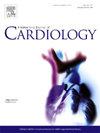近亲结婚人群中儿童期胸主动脉扩张的遗传变异。
IF 3.2
2区 医学
Q2 CARDIAC & CARDIOVASCULAR SYSTEMS
引用次数: 0
摘要
简介儿童期发病的胸主动脉扩张(TAD)是一组异质性遗传病,其遗传方式主要为显性遗传。据我们所知,近亲结婚对儿童期发病的 TAD 的影响尚未得到系统研究。我们的目的是研究我国高度近亲繁殖人群中的一组 TAD 儿童:方法:连续招募 TAD 儿童。根据创始基因突变的可能性,将基因检测分为定向基因检测或多基因测序,然后对一级亲属进行基因筛查。对临床数据和结果进行了回顾:结果:来自 20 个家庭的 33 名儿童患有儿童期 TAD。13个家庭的20名儿童基因检测呈阳性,阳性率为65%(13/20)。TAD 的中位发病年龄为 4.5 岁。在 4 个基因(FBN1、EFEMP2、ACTA2、KANSL1)中发现了 8 个变异基因,其中 6 个家庭(46.2%)发现了同卵 EFEMP2 变异基因。14例(70%)患者(13例为EFEMP2变异体,1例为FBN1变异体)需要手术治疗,中位年龄为3.5岁。所有患者均存活(年龄范围:3-31 岁):我们的工作说明了近亲结婚对儿童期发病的 TAD 遗传学的影响,阐明了隐性遗传形式的严重表现。我们的数据强调了遗传筛查和早期识别 TAD 的重要性,以获得最佳治疗效果。本文章由计算机程序翻译,如有差异,请以英文原文为准。
Genetic variants in childhood-onset dilatation of thoracic aorta in a consanguineous population
Introduction
Childhood-onset thoracic aortic dilatation (TAD) is a heterogenous group of genetic conditions the inheritance of which is largely dominant. To our knowledge, the influence of consanguinity on childhood-onset TAD has not been addressed systematically. We aim to study a cohort of children with TAD in our highly consanguineous population.
Methods
Children with TAD were consecutively recruited. Based on the likelihood of a founder mutation, genetic test was categorized to either targeted gene testing or multi-gene sequencing, followed by genetic screening of first-degree relatives. Clinical data and outcome were reviewed.
Results
Thirty-three children, from 20 families, had childhood-onset TAD. Genetic test was positive in 20 children, from 13 families, providing a yield of 65 % (13/20). The median age of onset of TAD was 4.5 years. Eight variants were detected in 4 genes (FBN1, EFEMP2, ACTA2, KANSL1) with a homozygous EFEMP2 variant found in 6 families (46.2 %). Surgical intervention was required in 14 (70 %) cases (13 with EFEMP2, 1 with FBN1 variants) at a median age of 3.5 years. All patients are alive (ages range:3–31 years).
Conclusions
Our work illustrates the impact of consanguinity on the genetics of childhood-onset TAD elucidating severe presentation of recessively inherited form. Our data underscores the importance of genetic screening and early recognition of TAD to achieve excellent outcome.
求助全文
通过发布文献求助,成功后即可免费获取论文全文。
去求助
来源期刊

International journal of cardiology
医学-心血管系统
CiteScore
6.80
自引率
5.70%
发文量
758
审稿时长
44 days
期刊介绍:
The International Journal of Cardiology is devoted to cardiology in the broadest sense. Both basic research and clinical papers can be submitted. The journal serves the interest of both practicing clinicians and researchers.
In addition to original papers, we are launching a range of new manuscript types, including Consensus and Position Papers, Systematic Reviews, Meta-analyses, and Short communications. Case reports are no longer acceptable. Controversial techniques, issues on health policy and social medicine are discussed and serve as useful tools for encouraging debate.
 求助内容:
求助内容: 应助结果提醒方式:
应助结果提醒方式:


